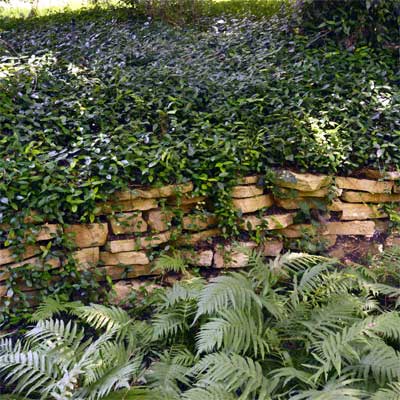From the Sperry Gardens – June, 2012

Of Grade Changes and Groundcovers
To build our house 36 years ago, we had to find a spot close enough to being level that would allow us to scrape off a pad site. That pad site (and now our house) was 25 feet directly behind me as I took this photograph, and this little retaining wall provided a way that we could level the ground without losing trees.
The retaining wall has held up perfectly for all of those years, and it’s obviously done its job well. The trees are still growing well, and no mudslide has ever come down the hill and pushed through our house. Life is good in the Sperry gardens.
I remember my first trip to the stone yard when I chose these ledge stones. It was like a kid going into a toy store — dozens of kinds of beautiful stones from all over the Southwest. I took all my garden measurements in with me, and those folks knew how to guide me in choosing the proper type of stone for my wall. This stone lies flat, yet it holds in place without sliding. This was a do-it-myself project, and I stacked the stones with a slight backward slope. That helps the stack maintain its integrity against the weight of waterlogged soils following rains.
I wore goggles, and I used a rock hammer to knock off the corners and tailor the stones. The stone yard told me to order 15 percent more stone than I needed, and those extra stones are now in use in smaller projects around our garden. It all was comparatively easy, and I’ve been really happy with the results.
Of course, it wouldn’t be a real landscape if the retaining wall didn’t have some types of plantings around it, and that’s where I called on two long-proven Texas groundcovers. At the time that I planted the top of the slope with Asian jasmine, I wasn’t really sure how well it would do in the shade. Well, it has performed heroically. It (and I) couldn’t be happier. And, the wood ferns on the lower level have been there for 30 years or longer, just doing their thing every summer. I like their texture against the much bolder look of the retaining stones.
That’s what I have for you this issue. It’s a small message from a little place in our landscape, but maybe it will help you do some problem-solving in your own gardens.

